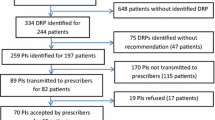Abstract
Background
Polypharmacy in older people should be addressed by an annual review of the chronic medication. In the PIL-study this was done by an integrated approach by GP, practice nurse, pharmacist, specialist and patient. All patients were first visited at home by the practice nurse.
Research questions
What ‘over the counter’ (OTC) medications do polypharmacy patients use? Do they know the indications of the prescribed medication? Does medication use according to the patient match with medication use according to the records of GP and pharmacist?
Method
Inclusion criteria were: age 60 years or older, daily use of five or more chronic medications, mental competence, and adequate command of the Dutch language. All patients were visited at home by the practice nurse, who made an inventory of the actual drug use.
Results
Five hundred fifty patients used a total of 5576 drugs, including 527 (9.4%) OTC medication. Patients knew the indication of 64% of the prescribed medication. The number of prescribed drugs that a patient actually used did not match the numbers known to GP and pharmacist. In 60.4% of all medication prescriptions there was complete agreement between GP, pharmacist and patient. On a patient level agreement was 18.7%.
Conclusions
Home visits by the nurse practitioner to make an inventory of the medication as reported by the patient seem to have an added value.
Samenvatting
Achtergrond
Om polyfarmacie bij ouderen aan te pakken wordt een jaarlijkse beoordeling van de chronische medicatie aanbevolen. In de PIL-studie gebeurde dit door een geïntegreerde aanpak door huisarts, praktijkondersteuner, apotheker, specialist en patiënt. Hierbij werden alle patiënten thuis bezocht door de praktijkondersteuner.
Vraagstelling
Welke zelfzorgmedicatie gebruiken polyfarmacie patiënten? Kennen patiënten de indicaties van de voorge-schreven medicatie? In hoeverre komen medicatiegebruik volgens de patiënt, en volgens de registraties van huisartsen en apothekers met elkaar overeen?
Methode
Inclusiecriteria waren leeftijd 60 jaar of ouder, dagelijks gebruik van vijf of meer chronische geneesmiddelen, wilsbekwaamheid, en voldoende beheersing van het Nederlands. Alle patiënten werden thuis bezocht door de praktijkondersteuner, die het daadwerkelijk medicijngebruik inventariseerde.
Resultaten
Vijfhonderdvijftig patiënten van 60 jaar of ouder met polyfarmacie gebruikten in totaal 5576 medicijnen, waarvan 527 (9,4%) zelfzorgmedicatie. Patiënten kenden van 64% van de voorgeschreven geneesmiddelen de indicatie. Het aantal voorgeschreven geneesmiddelen dat een patiënt daadwerkelijk gebruikt komt niet overeen met wat bij huisarts en apotheker bekend is. Bij 60,4% van alle voorgeschreven medicatie was er volledige overeenstemming in voorschrift en gebruik bij huisarts, apotheker en patiënt. Op patiëntniveau was de overeenstemming 18,7%.
Conclusies
Inventarisatie van het medicatiegebruik door een praktijkondersteuner bij de patiënt thuis lijkt meerwaarde te hebben.





Similar content being viewed by others
Literatuur
Multidisciplinaire richtlijn Polyfarmacie bij ouderen 2012. Utrecht: Nederlands Huisartsen Genootschap, 2012.
Olson M, Tong G, Steiner B, Viera A, Ashkin A, Newton W. Medication documentation in a primary care network serving North Carolina medicaid patients: results of a cross-sectional chart review. BMC Fam Pract. 2012;13:83.
Balon J, Thomas S. Comparison of hospital admission medication lists with primary care physician and outpatient pharmacy lists. J Nurs Scholarship. 2011;43:292-300.
Taskforce on Medicines and Partnership, the National Collaborative Medicines Management Services Program. Room for review. A guide to medication review: the agenda for patients, practitioners and managers. London: Medicines Partnership, 2002.
PIL studie. Polyfarmacie Interventie Limburg. www.pil-studie.nl (bezocht op 21 september 2012)
Barat I, Andreasen F, Damsgaard EMS. The consumption of drugs by 75-year-old individuals living in their own homes. Eur J Clin Pharmacol 2000;56:501-9.
www.trialregister.nl/trialreg/admin/rctview.asp?TC=2154 (bezocht op 21 september 2012)
Hussey M, Hughes J. Design and analysis of stepped wedge cluster randomized trials. Contemp Clin Trials. 2007;28:182-91.
Brown C, Lilford R. The stepped wedge trial design: a systematic review. BMC Med Res Methodol. 2006;6:54.
Stichting Farmaceutische Kengetallen (SFK). Data en feiten 2011. Den Haag: Stichting Farmaceutische Kengetallen, 2011.
Gezondheidsraad Multimorbiditeit bij ouderen. Den Haag: Gezondheidsraad, 2007.
Author information
Authors and Affiliations
Corresponding author
About this article
Cite this article
Bosch-Lenders, D., van den Akker, M., Stoffers, H.E.J.H. et al. Wat weten de patiënt en zijn hulpverlener: de meerwaarde van een huisbezoek door de praktijkondersteuner bij de medicatiebeoordelingen van patiënten met polyfarmacie in de eerste lijn. Tijdschr Gerontol Geriatr 44, 72–80 (2013). https://doi.org/10.1007/s12439-013-0015-7
Published:
Issue Date:
DOI: https://doi.org/10.1007/s12439-013-0015-7




